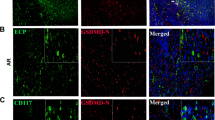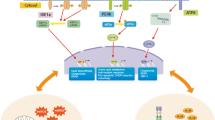Abstract
Background
Allergic disorders are common all over the world. The pathogenesis of allergy is unclear. Therapies for allergic disorders require improvement. Endoplasmic reticulum (ER) stress is one of the factors influencing immune response. The purpose of this study is to improve the effectiveness of immunotherapy for experimental respiratory allergy by targeting the ER stress signal pathway.
Methods
Committed CD4+ T cells were isolated from blood samples collected from patients with allergic rhinitis (AR) and TCR ovalbumin transgenic mice. The effects of TCR engagement and 3-methyl-4-nitrophenol (MNP) on inducing ER stress in committed CD4+ T cells were evaluated.
Results
ER stress was detected in antigen-specific CD4+ T cells (sCD4+ T cells) of AR patients. The environmental pollutant MNP increased the expression of the X-binding protein-1 (XBP1) in the committed CD4+ T cells during the TCR engagement. XBP1 mediated the effects of MNP on inhibiting regulatory T cell (Treg) generation. The effects of MNP on induction of protein 20 (Rnf20) in CD4+ T cells were mediated by XBP1. Inhibition of Rnf20 rescued the Treg development from MNP-primed sCD4+ T cells. The ablation of Rnf20 improved the immunotherapy of AR through the restoration of the Treg generation.
Conclusions
ER stress can be detected in CD4+ T cells in TCR engagement. Exposure to MNP exacerbates ER stress in committed CD4+ T cells. Regulation of the ER stress-related Rnf20 expression can restore the generation of Treg from CD4+ T cells of subjects with allergic diseases.







Similar content being viewed by others
Data availability
All the data are included in this paper.
References
Dominguez-Villar M, Hafler DA (2018) Regulatory T cells in autoimmune disease. Nat Immunol 19(7):665–673
Tanoue T, Atarashi K, Honda K (2016) Development and maintenance of intestinal regulatory T cells. Nat Rev Immunol 16(5):295–309
Oakes SA, Papa FR (2015) The role of endoplasmic reticulum stress in human pathology. Annu Rev Pathol 10:173–194
Ron D, Walter P (2007) Signal integration in the endoplasmic reticulum unfolded protein response. Nat Rev Mol Cell Biol 8(7):519–529
Kaech SM, Wherry EJ, Ahmed R (2002) Effector and memory T-cell differentiation: implications for vaccine development. Nat Rev Immunol 2(4):251–262
Mims JW (2015) Asthma: definitions and pathophysiology. Int Forum Allergy Rhinol 5(Suppl 1):S2-6
Tian GX, Peng KP, Liu MH, Tian DF, Xie HQ, Wang LW, Guo YY, Zhou S, Mo LH, Yang PC (2022) CD38(+) B cells affect immunotherapy for allergic rhinitis. J Allergy Clin Immunol 149(5):1691-1701.e9
Pfistershammer K, Majdic O, Stöckl J, Zlabinger G, Kirchberger S, Steinberger P, Knapp W (2004) CD63 as an activation-linked T cell costimulatory element. J Immunol 173(10):6000–6008
Pope CA 3rd, Burnett RT, Thun MJ, Calle EE, Krewski D, Ito K, Thurston GD (2002) Lung cancer, cardiopulmonary mortality, and long-term exposure to fine particulate air pollution. JAMA 287(9):1132–1141
Pope CA 3rd, Coleman N, Pond ZA, Burnett RT (2020) Fine particulate air pollution and human mortality: 25+ years of cohort studies. Environ Res 183:108924
Yoshida H, Matsui T, Yamamoto A, Okada T, Mori K (2001) XBP1 mRNA is induced by ATF6 and spliced by IRE1 in response to ER stress to produce a highly active transcription factor. Cell 107(7):881–891
Cortez JT, Montauti E, Shifrut E, Gatchalian J, Zhang Y, Shaked O, Xu Y, Roth TL, Simeonov DR, Zhang Y, Chen S, Li Z, Woo JM, Ho J, Vogel IA, Prator GY, Zhang B, Lee Y, Sun Z, Ifergan I, Van Gool F, Hargreaves DC, Bluestone JA, Marson A, Fang D (2020) CRISPR screen in regulatory T cells reveals modulators of Foxp3. Nature 582(7812):416–420
Wiegman CH, Michaeloudes C, Haji G, Narang P, Clarke CJ, Russell KE, Bao W, Pavlidis S, Barnes PJ, Kanerva J, Bittner A, Rao N, Murphy MP, Kirkham PA, Chung KF, Adcock IM (2015) Oxidative stress-induced mitochondrial dysfunction drives inflammation and airway smooth muscle remodeling in patients with chronic obstructive pulmonary disease. J Allergy Clin Immunol 136(3):769–780
Lee HY, Lee GH, Kim HK, Chae HJ (2019) Platycodi Radix and its active compounds ameliorate against house dust mite-induced allergic airway inflammation and ER stress and ROS by enhancing anti-oxidation. Food Chem Toxicol 123:412–423
Calfon M, Zeng H, Urano F, Till JH, Hubbard SR, Harding HP, Clark SG, Ron D (2002) IRE1 couples endoplasmic reticulum load to secretory capacity by processing the XBP-1 mRNA. Nature 415(6867):92–96
Shaffer AL, Shapiro-Shelef M, Iwakoshi NN, Lee AH, Qian SB, Zhao H, Yu X, Yang L, Tan BK, Rosenwald A, Hurt EM, Petroulakis E, Sonenberg N, Yewdell JW, Calame K, Glimcher LH, Staudt LM (2004) XBP1, downstream of Blimp-1, expands the secretory apparatus and other organelles, and increases protein synthesis in plasma cell differentiation. Immunity 21(1):81–93
Cubillos-Ruiz JR, Silberman PC, Rutkowski MR, Chopra S, Perales-Puchalt A, Song M, Zhang S, Bettigole SE, Gupta D, Holcomb K, Ellenson LH, Caputo T, Lee AH, Conejo-Garcia JR, Glimcher LH (2015) ER stress sensor XBP1 controls anti-tumor immunity by disrupting dendritic cell homeostasis. Cell 161(7):1527–1538
Song M, Sandoval TA, Chae CS, Chopra S, Tan C, Rutkowski MR, Raundhal M, Chaurio RA, Payne KK, Konrad C, Bettigole SE, Shin HR, Crowley MJP, Cerliani JP, Kossenkov AV, Motorykin I, Zhang S, Manfredi G, Zamarin D, Holcomb K, Rodriguez PC, Rabinovich GA, Conejo-Garcia JR, Glimcher LH, Cubillos-Ruiz JR (2018) IRE1α-XBP1 controls T cell function in ovarian cancer by regulating mitochondrial activity. Nature 562(7727):423–428
Sheng X, Nenseth HZ, Qu S, Kuzu OF, Frahnow T, Simon L, Greene S, Zeng Q, Fazli L, Rennie PS, Mills IG, Danielsen H, Theis F, Patterson JB, Jin Y, Saatcioglu F (2019) IRE1α-XBP1s pathway promotes prostate cancer by activating c-MYC signaling. Nat Commun 10(1):323
Mori Y, Kamata K, Toda N, Hayashi H, Seki K, Taneda S, Yoshino S, Sakushima A, Sakata M, Suzuki AK (2003) Isolation of nitrophenols from diesel exhaust particles (DEP) as vasodilatation compounds. Biol Pharm Bull 26(3):394–395
Takeo M, Yamamoto K, Sonoyama M, Miyanaga K, Kanbara N, Honda K, Kato DI, Negoro S (2018) Characterization of the 3-methyl-4-nitrophenol degradation pathway and genes of Pseudomonas sp. strain TSN1. J Biosci Bioeng 126(3):355–362
Sethi G, Shanmugam MK, Arfuso F, Kumar AP (2018) Role of RNF20 in cancer development and progression—a comprehensive review. Biosci Rep. https://doi.org/10.1042/BSR20171287
Sakaguchi S, Mikami N, Wing JB, Tanaka A, Ichiyama K, Ohkura N (2020) Regulatory T cells and human disease. Annu Rev Immunol 38:541–566
Funding
This study was supported by research grants of the National Natural Science Foundation of China (81900914, 32090052), Guangdong Provincial Key Laboratory of Regional Immunity and Diseases (2019B030301009) and Shenzhen science, technology and innovation committee (KQTD20170331145453160).
Author information
Authors and Affiliations
Contributions
XL, LM, XW, SZ, HL and GW performed experiments, analyzed data and reviewed the manuscript. PY, DL and QH organized the project and supervised experiments. PY designed the project and prepared the manuscript.
Corresponding authors
Ethics declarations
Conflict of interest
The authors declare that they have no conflict of interest.
Additional information
Publisher's Note
Springer Nature remains neutral with regard to jurisdictional claims in published maps and institutional affiliations.
Supplementary Information
Below is the link to the electronic supplementary material.
Rights and permissions
Springer Nature or its licensor (e.g. a society or other partner) holds exclusive rights to this article under a publishing agreement with the author(s) or other rightsholder(s); author self-archiving of the accepted manuscript version of this article is solely governed by the terms of such publishing agreement and applicable law.
About this article
Cite this article
Luo, X., Mo, L., Wang, X. et al. Rnf20 inhibition enhances immunotherapy by improving regulatory T cell generation. Cell. Mol. Life Sci. 79, 588 (2022). https://doi.org/10.1007/s00018-022-04613-7
Received:
Revised:
Accepted:
Published:
DOI: https://doi.org/10.1007/s00018-022-04613-7




